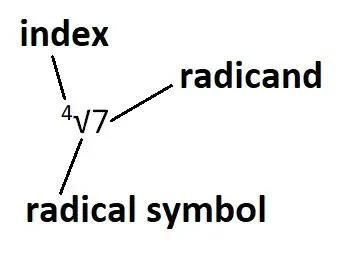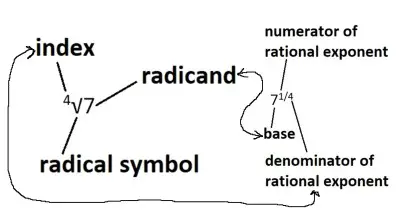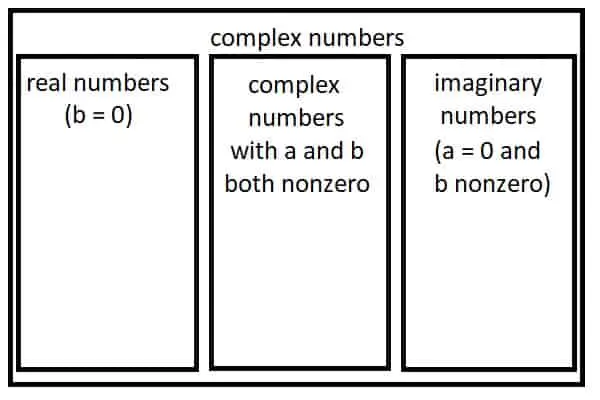When we deal with radicals, we need to know the various parts and how they affect the value of the radical. For example, the index of a radical is important, but we also need to understand the radicand.
So, what is a radicand? A radicand is the number under a radical symbol – it is the value we are taking a root of. The index tells us whether to take the square root, cube root, or another root of a radicand. Depending on the value of the radicand and index, we may get real roots, pure imaginary roots, or complex roots.
Of course, we can also have fractions or decimals as radicands. We just might need to take a few extra steps to simplify in some of these cases.
In this article, we’ll talk about radicands, including what they are and what values they can take on. We will also give some examples to show the various cases, to get a better grasp on the concept of radicands.
Let’s get started.
What Is A Radicand?
A radicand is the number or expression under a radical symbol. For the radical n√x, we say that n is the index and x is the radicand.

The radicand is the value we are taking the root of. For the radical n√x, we say that we are taking “the nth root of x.”
So, the index tells us whether to take square root (n = 2), cube root (n = 3), fourth root (n = 4), or another root of a radicand.

The value of the radicand, along with the index, will tell us the type of number we get as a result. We may get:
- real numbers, such as √9 = 3
- pure imaginary numbers, such as √(-4) = 2i
- complex numbers, such as 4√(-64) = 2 – 2i
Let’s take a closer look at some of the various cases for radicands, starting with fractions.
Can A Radicand Be A Fraction?
A radicand can be a fraction. For example, 3√(7/5) is a perfectly valid expression. In this case, the radicand is 7/5 (a fraction), and the index is 3.
Sometimes, we can simplify a radicand that is a fraction. Let’s look at an example.
Example 1: Simplifying A Radicand That Is A Fraction
Consider the radical √(9/4). The index is 2 (square root) and the radicand is the fraction 9/4.
Remember the rule that √(a/b) = √a/√b.
Applying this rule to the radical √(9/4), we get:
- √(9/4) [original radical]
- =√9/√4 [used the rule √(a/b) = √a/√b with a = 9 and b = 4]
- =3/2 [√9 = 3 and √4 = 2]
So, we can simplify √(9/4) to the fraction 3/2.
Note that we were able to simplify because both 9 and 4 are perfect squares.
In other cases, we won’t be able to simplify a radicand that is a fraction.
Example 2: A Radicand That Is A Fraction That Cannot Be Simplified
Consider the radical √(8/3). The index is 2 (square root) and the radicand is the fraction 8/3.
Note that:
- 8 and 3 have no common factors, so we cannot reduce 8/3 to any other fraction
- 8 is not a perfect square (it is between the perfect squares 4 and 9)
- 3 is not a perfect square (it is between the perfect squares 1 and 4)
This means that there is nothing we can do to simplify this radical.
Example 3: A Radicand That Is A Fraction That Can Be Partially Simplified
Consider the radical √(9/12). The index is 2 (square root) and the radicand is the fraction 9/12.
Note that we can simplify the fraction 9/12 to 3/4 (dividing out 3 from both the numerator and denominator).
Now, the fraction cannot be reduced any further, since 3 and 4 have no common factors.
However, 4 is a perfect square, so we can simplify the radical a little bit more.
Again using the rule that √(a/b) = √a/√b, we get:
- √(3/4) [original radical]
- =√3/√4 [used the rule √(a/b) = √a/√b with a = 3 and b = 4]
- =√3/2 [√9 = 3]
So, we can simplify √(3/4) to the fraction √3/2.
Can A Radicand Be A Decimal?
A radicand can be a decimal, just like a radicand can be a fraction. In fact, we can convert any terminating decimal to a radical – for example, 0.27 has the same value as the fraction 27/100.
We can use this conversion and the rules above to simplify radicands that are decimals.
Example 1: Simplifying A Radicand That Is A Decimal
Consider the radical √(0.09). The index is 2 (square root) and the radicand is the decimal 0.09.
We can convert 0.09 to the fraction 9/100.
Now we use the rule that √(a/b) = √a/√b to simplify.
Applying this rule to the radical √(9/100, we get:
- √(9/100) [original radical]
- =√9/√100 [used the rule √(a/b) = √a/√b with a = 9 and b = 100]
- =3/10 [√9 = 3 and √100 = 10]
So, we can simplify √(9/100) to the fraction 3/10.
We can also convert 3/10 back to a decimal to get 0.3.
To check our work, we can calculate 0.3*0.3 = 0.09, which confirms that 0.3 is the square root of 0.09.
Note that we were able to simplify because both 9 and 100 are perfect squares.
In other cases, we won’t be able to simplify a radicand that is a decimal.
Example 2: A Radicand That Is A Decimal That Cannot Be Simplified
Consider the radical √(0.3). The index is 2 (square root) and the radicand is the decimal 0.3.
We can convert 0.3 to the fraction 3/10.
Note that:
- 3 and 10 have no common factors, so we cannot reduce 3/10 to any other fraction
- 3 is not a perfect square (it is between the perfect squares 1 and 4)
- 10 is not a perfect square (it is between the perfect squares 9 and 16)
This means that there is nothing we can do to simplify this radical.
Example 3: A Radicand That Is A Decimal That Can Be Partially Simplified.
Consider the radical √(0.75). The index is 2 (square root) and the radicand is the decimal 0.75
We can convert the decimal 0.75 to 75/100. We can then reduce 75/100 to the fraction 3/4 (by dividing 25 out of both the numerator and denominator).
Now, the fraction cannot be reduced any further, since 3 and 4 have no common factors.
However, 4 is a perfect square, so we can simplify the radical a little bit more.
Again using the rule that √(a/b) = √a/√b, we get:
- √(3/4) [original radical]
- =√3/√4 [used the rule √(a/b) = √a/√b with a = 3 and b = 4]
- =√3/2 [√9 = 3]
So, we can simplify √(3/4) to the fraction √3/2, and the radical √0.75 is equivalent to √3/2.
Can A Radicand Be Negative?
A radicand can be negative. However, the result may be a real, pure imaginary, or complex number, depending on the index of the radical.
In general:
- A negative radicand with an odd index gives us a negative number as a result.
- A negative radicand with an even index gives us a complex number (with nonzero imaginary part) as a result.

The table below summarizes the values we get depending on the sign of the radicand (positive or negative) and the parity of the index (even or odd).
| Sign Of Radicand | Even Index | Odd Index |
|---|---|---|
| + | Real, Positive | Real, Positive |
| 0 | 0 | 0 |
| – | Complex | Real, Negative |
of a radical with the indicated radicand
sign and index parity.
Negative Radicand With Odd Index
When we have a negative radicand with an odd index, we get a negative number as a result. This makes sense, since:
- a product of two negatives is positive, while a product of three negatives is negative
- a product of four negatives is positive, while a product of five negatives is negative
- etc.
Specifically, if x is negative and n is odd, then:
- n√x = – n√|x|
Let’s look at some examples.
Example 1: Negative Radicand With Odd Index
Consider the radical 3√-8. This is a radical with a negative radicand of -8 and an odd index of 3.
This means that the result will be a negative number. Specifically, the cube root of 8 is 2, so the cube root of -8 must be -2.
We can verify this by cubing -2:
- (-2)3
- =(-2)*(-2)*(-2)
- =4*(-2)
- =-8
Example 2: Negative Radicand With Odd Index
Consider the radical 5√-243. This is a radical with a negative radicand of -243 and an odd index of 5.
This means that the result will be a negative number. Specifically, the fifth root of 243 is 3, so the fifth root of -243 must be -3.
We can verify this by raising -3 to the fifth power:
- (-3)5
- =(-3)*(-3)*(-3) *(-3) *(-3)
- =9*(-3) *(-3) *(-3)
- =9*9*(-3)
- =81*(-3)
- =-243
Example 3: Negative Radicand With Odd Index
Consider the radical 3√(-0.008). This is a radical with a negative radicand of -0.008 and an odd index of 3.
This means that the result will be a negative number. Specifically, the cube root of 0.008 is 0.2, so the cube root of -0.008 must be -0.2.
We can verify this by raising -0.2 to the third power:
- (-0.2)3
- =(-0.2)*(-0.2)*(-0.2)
- =0.04*(-0.2)
- =-0.008
Negative Radicand With Even Index
When we have a negative radicand with an even index, we get a complex number with a nonzero imaginary part as a result. This makes sense, since:
- The square root of a negative number is imaginary
- Any even root (fourth root, sixth root, etc.) is really an even root of a square root (for example the sixth root of -64 is the third root of the square root of -64)
Let’s look at some examples.
Example 1: Negative Radicand With Even Index
Consider the radical √(-16). This is a radical with a negative radicand of -16 and an even index of 2.
This means that the result will be an imaginary number. Specifically, the square root of 16 is 4, so the square root of -16 must be 4i.
We can verify this by squaring 4i:
- (4i)2
- =16i2
- =16(-1) [since i2 = -1, because i = √-1 by definition]
- =-16
Example 2: Negative Radicand With Even Index
Consider the radical 4√(-324). This is a radical with a negative radicand of -324 and an even index of 4.
This means that the result will be a complex number. It turns out that we get a value of 3 – 3i.
We can verify this by raising 3 – 3i to the fourth power:
- (3 – 3i)4
- =((3 – 3i)2)2 [since (a2)2 = a4 by rules of exponents]
- =((3 – 3i)(3– 3i))2
- =(9 – 9i – 9i + 9i2)2 [used FOIL on the product (3 – 3i)(3 – 3i)]
- =(9 – 18i + 9i2)2 [combined like terms]
- =(9 – 18i + 9(-1))2 [since i2 = -1, because i = √-1 by definition]
- =(9 – 18i – 9)2
- =(– 18i)2
- =324i2
- =324(-1)
- =-324 [since i2 = -1, because i = √-1 by definition]
Can You Add Radicands?
You cannot add radicands. As a simple example, consider √4 + √9. This simplifies to:
- √4 + √9
- =2 + 3
- =5
This does not give the same result as adding the radicands, which gives us the wrong answer: √(4+9) = √13, which is not equal to 5.
However, if you have two radicands that have the same index and the same radicand, then you can combine like terms.
For example, let’s say you have 3√5 + 3√5. In that case, you can combine like terms to get 2*3√5.
You can learn more about adding, subtracting, multiplying, and dividing square roots here.

Conclusion
Now you know a little more about radicands: what they are, when they are used, and how they relate to the index of a radical.
You can learn all about radical equations here.
I hope you found this article helpful. If so, please share it with someone who can use the information.
Don’t forget to subscribe to our YouTube channel & get updates on new math videos!


